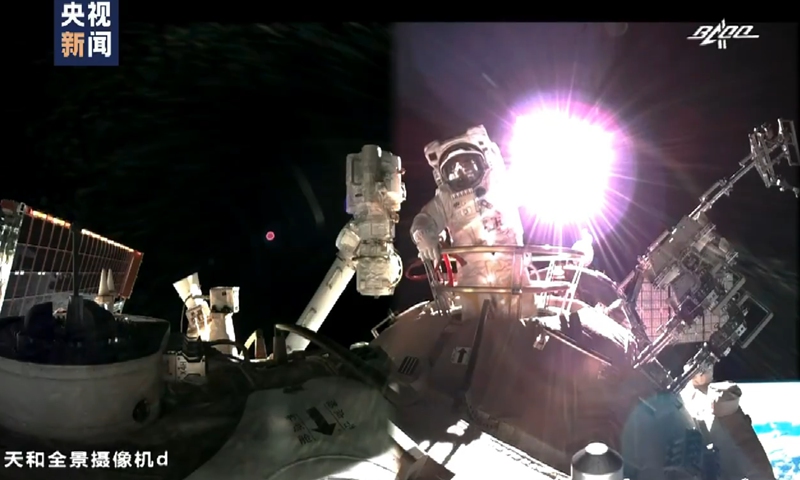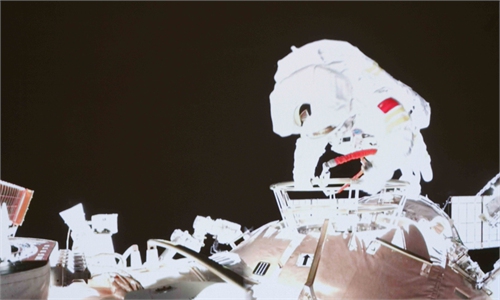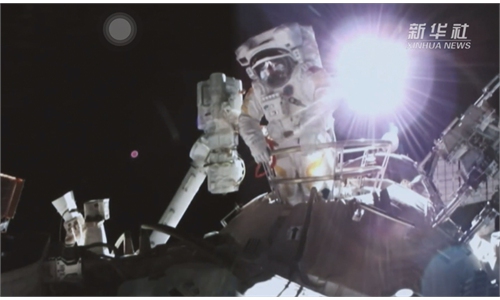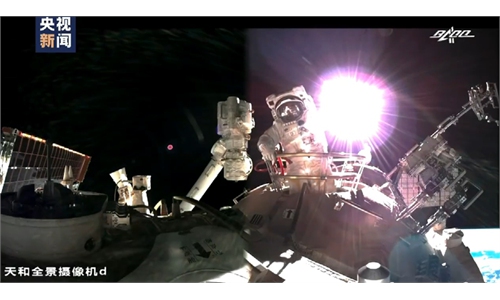Two close encounters of Starlink satellites possibly aimed to test China’s sensibility in space: expert

Shenzhou-13 taikonaut Ye Guangfu opened the cabin and came out for the crew's 2nd spacewalk mission. Photo: CCTV
The possibility cannot be ruled out that Space Exploration Technologies Corporation (SpaceX) is trying to test China's capability and response awareness in space, experts said after the Committee on the Peaceful Uses of Outer Space (COPUOS) revealed that the US company's Starlink satellites had two close encounters with the China Space Station, leading the latter to implement preventive collision avoidance control for safety reasons.
The two encounters were revealed in a note verbale dated December 3 that the Permanent Mission of China to the United Nations (Vienna) addressed to the Secretary-General of the UN. The note was published on the website of the United Nations Office for Outer Space Affairs on December 6.
According to the note, China completed five launch missions in 2021, with the successful launch into orbit of the Tianhe core module of the China Space Station, the Tianzhou-II and Tianzhou-III cargo spacecraft and the Shenzhou-XII and Shenzhou-XIII crewed spacecraft. The China Space Station is in a stable near-circular orbit at an altitude of around 390 kilometers on an orbital inclination of about 41.5 degrees.
However, during this period, Starlink satellites launched by SpaceX had two close encounters with the China Space Station separately on July 1 and October 21, according to the note.
Huang Zhicheng, a senior expert on aerospace science and technology, told the Global Times on Monday that the Starlink satellites launched by SpaceX had always orbited an altitude of around 550 kilometers.
According to the note, China implemented preventive collision avoidance control during the two occasions because the Starlink satellites descended to lower orbits, which could be to enhance satellites' regional communication capacity as the company also planned to launch a batch of satellites into an orbit of around 330 kilometers.
"But we can't rule out the possibility that the move is intended to test China's capacity in space to check whether China can accurately grasp the satellites' actions," Huang said.
From April 19, 2020, the Starlink-1095 satellite was in stable orbit at an average altitude of around 555 kilometers. Between May 16 and June 24, 2021, the Starlink-1095 satellite maneuvered continuously to an orbit of around 382 kilometers, and then stayed in that orbit. A close encounter occurred between the Starlink-1095 satellite and the China Space Station on July 1, 2021.
On October 21, 2021, the Starlink-2305 satellite had a subsequent close encounter with the China Space Station. As the satellite was continuously maneuvering, the maneuver strategy was unknown and orbital errors were hard to assess, so there was a collision risk between the Starlink-2305 satellite and the China Space Station.
The Treaty on Principles Governing the Activities of States in the Exploration and Use of Outer Space provides that state parties to the Treaty shall immediately inform the other state parties to the Treaty or the Secretary-General of the UN of any phenomena they discover in outer space. China informed the Secretary-General of the two encounters, which constituted dangers to the life or health of the astronauts aboard the China Space Station, according to the note.
According to media reports, SpaceX has launched almost 1,900 satellites. The company has approval for 30,000 more satellites, in addition to previous permission for about 12,000.
Such an intense satellite network will absolutely threaten other countries' spacecraft. The deployment of 40,000 satellites will also definitely affect other countries' launches, Huang warned.



